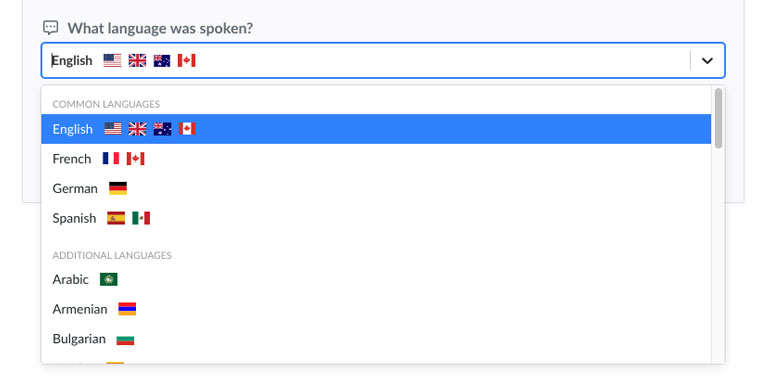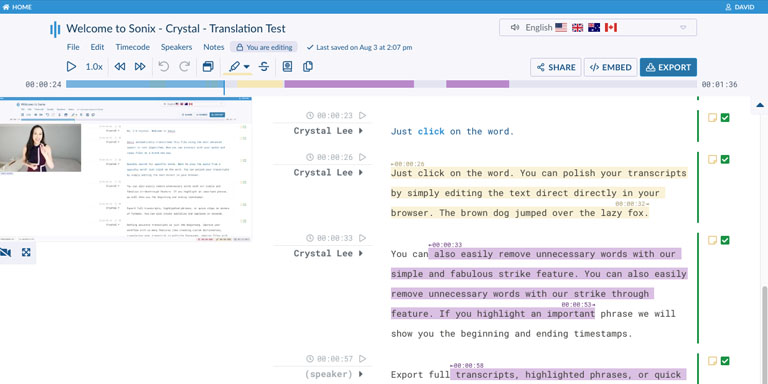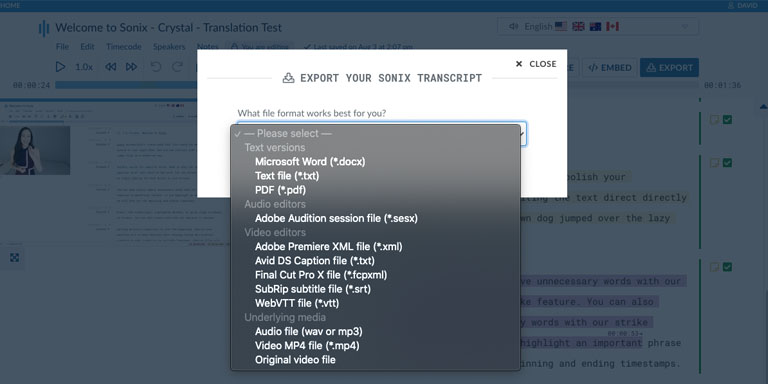Thousands of Sonix customers convert their Chinese (Cantonese) OPUS files to text 
What's the best way to convert Chinese (Cantonese) OPUS files to text? 
Use Sonix to convert Chinese (Cantonese) OPUS files to text
Follow these six easy steps to quickly and easily convert your Chinese (Cantonese) OPUS files to text:
Step 1: Log into your Sonix account
If you don't have one, you can sign up for Sonix's free account—30 minutes of free transcription/translation.

Step 2: Upload your Chinese (Cantonese) OPUS file
In Sonix, click “Upload” and locate the Chinese (Cantonese) OPUS file on your computer.

Step 3: Choose language: Chinese (Cantonese)
Select Chinese (Cantonese) in the dropdown that asks 'What language was spoken?.' Then, click the “Transcribe” button.

Step 4: Sonix transcribes your OPUS file
Sonix automatically transcribes your Chinese (Cantonese) OPUS file and converts it to Chinese (Cantonese) text.

Step 5: Polish your Chinese (Cantonese) transcript
Edit your Chinese (Cantonese) transcript by typing directly into your browser to correct any words that were not transcribed perfectly.

Step 6: Export Chinese (Cantonese) text
Export the Chinese (Cantonese) text to any format you want including MS Word, PDF, subtitles, or a simple text file.

All done! You have now successfully converted your Chinese (Cantonese) OPUS file to text!
How to improve the accuracy of your Chinese (Cantonese) transcripts?
Start by improving the quality of the Chinese (Cantonese) OPUS file that you upload to Sonix. Please use high quality recording equipment, recording in a quiet environment, and ensure that your speakers are speaking clearly to ensure that your transcript is as accurate as possible.
Any advice for the Chinese (Cantonese) OPUS file that I upload?
Yes, please do not over-compress or over-filter the audio track of your Chinese (Cantonese) OPUS file. By uploading a high quality version of your audio, we can give you the best level of accuracy.
Aside from OPUS, do you support other types of audio/video files?
Yes, we do! You can convert the following file types in Chinese (Cantonese) with Sonix:
What customers say about Sonix's automated transcription 
The fact that your service can export text as subtitles and can match the subtitles to the paragraphs in the transcript is just great! Also, the text editor is just awesome. The fact it bonds text and timing in the video so I can check and compare what was pronounced and what was recognized is truly fantastic.
I cannot believe how easy, quick, and accurate this is.
I really enjoyed how quickly and accurate the transcription system was. Will definitely use again in the future. I have recommended you to a friend.
Awesome and I was really shocked when I saw how carefully my mp3 file was transcribed!!
Seriously the best transcript I’ve ever seen. And the synchronized editor is amazing. I will be using again and I will be sharing with my friends :)
My transcript work flow is so fast now. It takes me half the time it used to. So glad i found you :)
Want to see more testimonials?
We have a lot more customer testimonials
Convert Chinese (Cantonese) OPUS files to text with Sonix 
Sonix automatically transcribes and translates your audio/video files in 53+ languages. Easily search, edit, and share your media files. Sonix uses advanced transcription and translation algorithms to convert your Chinese (Cantonese) OPUS files to text both fast and accurate. Fast, accurate, and affordable. Millions of users from all over the world.
Includes 30 minutes of free transcription











